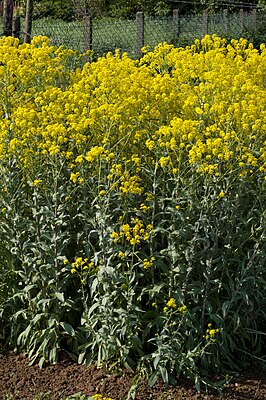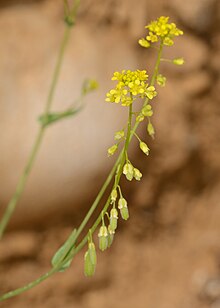Woad (genus)
| Woad | ||||||||||||
|---|---|---|---|---|---|---|---|---|---|---|---|---|

Woad ( Isatis tinctoria ) |
||||||||||||
| Systematics | ||||||||||||
|
||||||||||||
| Scientific name | ||||||||||||
| Isatis | ||||||||||||
| L. |
Waid ( Isatis ) is a genus of plants in the cruciferous family (Brassicaceae). The trivial name woad derived from althochdeutsch far : related to Latin "vitrum" ( 'woad', 'used for blue dyeing plant "," blue color "," bluish glass') from. The 50 to 94 species are found in Europe and North Africa , but mostly in Central and Southwest Asia.
description

Due to their extremely variable morphology , the Asian species in particular are difficult to identify; the only reliable diagnostic feature is the ripe fruit.
Vegetative characteristics
In Isatis TYPES comes to one, (usually) biennial or perennial herbaceous plants . They are often bluish and hairless or hairy. The upright stem is branched.
Most alternate, standing in undergraduate roses or distributed on the stem leaves are stalked or sessile. The leaf blades are elliptical-elongated, heart-shaped to ovate-elongated or arrow-shaped. The leaf margin is smooth, toothed or rarely lobed.
Generative characteristics
The mostly clustered , more rarely umbrella clustered or paniculate inflorescences are multi-flowered and extend considerably until the fruit is ripe. The flower stalks are thin and bent back when the fruit ripens.
The hermaphroditic flowers are four-fold with a double flower envelope (perianth). The four sepals are ascending to erect. The four yellow, white or purple petals are at least as long as the sepals. They have six stamens with very small, egg-shaped or elongated-round anthers. There are nectar glands .
Each fruit, it can pods or silicles be hairy or smooth fluffy and usually contains only one, rarely two seeds. The brownish, elongated-round seed is smooth.
Systematics
The generic name Isatis was first published in 1737 by Carl von Linné in Hortus Cliffortianus Plantas exhibens quas in Hortis vivis quam siccis, Hartecampi in Hollandia coluit , 341. Synonyms for Isatis L. are: Boreava Jaub. & Spach , Goerkemia Yıld. , Martinsia Godr. , Pachypteris Kar. & Kir. non Brongn. , Pachypterygium Bunge , Sameraria Desv. , Tauscheria fish. ex DC. , Tetrapterygium fish. & CAMey.
The genus Isatis belongs to the tribe Isatideae in the family Brassicaceae .
There are 50 to 94 types of Isatis (selection):
- Alpine woad ( Isatis alpina Vill .; Syn .: Isatis allionii P.W.Ball ): It occurs only in the Appennines and in the Italian and French Alps.
- Isatis aucheri Boiss. : It occurs in Turkey .
- Isatis boissieriana Rchb. f. : It occurs in Afghanistan , Turkmenistan and Uzbekistan .
- Isatis brevipes (Bunge) Jafri : It was first described from the Middle East.
- Isatis buschiana Shishk. : It occurs in Turkey , Iraq and Iran .
- Isatis cappadocica Desv. (Syn .: Isatis steveniana Trautv. ): It occurs in three subspecies in Turkey, Syria, Armenia , Azerbaijan , Dagestan , Iraq, Lebanon and Iran.
- Isatis costata C.A.Mey. : It occurs in European and Asian Russia , Crimea , Pakistan , Tajikistan, Kazakhstan, Mongolia and China.
- Isatis djurdjurae Coss. & Durieu : It occurs in Morocco and Algeria .
- Isatis emarginata Kar. & Kir. : It occurs in Pakistan, Kazakhstan, Uzbekistan, Turkmenistan and Iran.
- Isatis erzurumica P.H.Davis : It occurs in Turkey.
- Isatis gaubae Bornm. : It occurs in Iran.
- Isatis glauca Aucher ex Boiss. : It occurs in Turkey, Armenia and Syria.
- Isatis harsukhii O.E.Schulz : It was first described in Baluchistan.
- Isatis iberica Steven : It occurs in Armenia and Azerbaijan.
- Isatis kotschyana Boiss. & High. : It occurs in Turkey and Iran.
- Isatis lusitanica L. (Syn .: Isatis aleppica Scop. ): It occurs in Crete , Tunisia, Libya, the Sinai Peninsula , Turkey, Syria, Lebanon, Iraq, Jordan , Israel and Iran.
- Isatis microcarpa Boiss. : It only occurs on the Sinai Peninsula .
- Isatis minima Bunge : It occurs in Iran, Afghanistan, Pakistan, Central Asia and China.
- Isatis multicaulis (Kar. & Kir.) Jafri
- Formerly woad ( Isatis praecox Tratt. ):
- Isatis stocksii Boiss. : It was first described from Baluchistan.
- Woad ( Isatis tinctoria L. )
- Isatis violascens Bunge : It is widespread in sandy deserts in southwest Asia, Pakistan , Afghanistan , Kazakhstan , Kyrgyzstan , Tajikistan , Turkmenistan , Uzbekistan, and Xinjiang, China .
swell
- Tai-yien Cheo, Lianli Lu, Guang Yang, Ihsan Al-Shehbaz, Vladimir Dorofeev: Brassicaceae. : Isatis , pp. 35–37 - the same text online as the printed work , In der Flora of China , Volume 8, 2001: (section description)
- SMH Jafri: Brassicaceae in the Flora of Pakistan Isatis - Online.
- Ihsan A. Al-Shehbaz: Isatis , p. 567 - online with the same text as the printed work , in the Flora of North America , Volume 7, 2010. (Section description)
- H. Moazzeni et al .: Phylogeny of Isatis (Brassicaceae) and allied genera based on ITS sequences of nuclear ribosomal DNA and morphological characters. In: Flora (Elsevier) , Volume 205, 2010, pp. 337–343.
Individual evidence
- ↑ a b c d e f g h i j k l m n o p Isatis in the Germplasm Resources Information Network (GRIN), USDA , ARS , National Genetic Resources Program. National Germplasm Resources Laboratory, Beltsville, Maryland. Retrieved July 7, 2017.
- ↑ Database: BrassiBase, Version 1.2, March 2017 of the University of Heidelberg. ( Memento of the original from May 3, 2018 in the Internet Archive ) Info: The archive link was inserted automatically and has not yet been checked. Please check the original and archive link according to the instructions and then remove this notice.
- ↑ a b David Aeschimann, Konrad Lauber, Daniel Martin Moser, Jean-Paul Theurillat: Flora alpina. Volume 1 and 2. Bern, Stuttgart, Vienna Haupt-Verlag, 2004, ISBN 3-258-06600-0 .
- ↑ Jaakko Jalas, Juha Suominen: Atlas florae europaeae. Volume 10 Cruciferae (Sisymbrium to Aubrieta). Page 41, Helsinki 1994. ISBN 951-9108-09-2
- ↑ Karol Marhold: Brassicaceae . In: Euro + Med Plantbase - the information resource for Euro-Mediterranean plant diversity. Berlin 2011.
